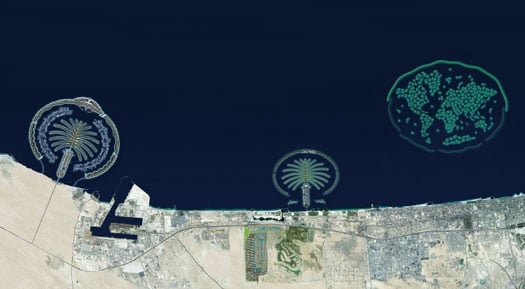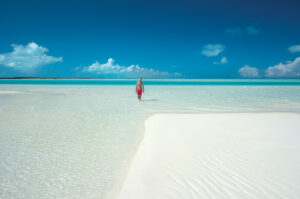
Dubai
Imagine being present at the building of the Pyramids-even better, being able to buy real estate at the corner of, say, Cheops and Luxor. Imagine if it were all water-accessible, like Venice, and sunnier than California, and all your neighbors were not only beautiful people, but boat owners, too. As the Beach Boys used to sing: Wouldn’t it be nice?
Well, guess what? Such a paradise is under construction, and it’s not Nice-or Cannes or Monaco. Instead, if the Boys were still together today they might well be singing, “Do you believe Dubai?”
Dubai, the southernmost city above the Strait of Hormuz, is a tax-free hub that is fast becoming a modern-day Hong Kong crossed with Las Vegas by way of Palm Beach. It has a bustling commercial harbor filled with working dhows and water taxis, a modern high-rise skyline, and an economy that is the envy of the world. Ruled by Sheikh Mohammed bin Rashid Al Maktoum, the Crown Prince of the United Arab Emirates (UAE), Dubai is the fastest-growing Emirate in the region, with a staggering 27 percent of the world’s high-rise cranes working to construct an ultramodern skyline and a verdant landscape out of the sand.
Still, maybe you’re asking, why would anybody go there? Leaving aside the fact that people once asked the same question about Las Vegas, the answer is: Follow the money. That’s right, forget Al-Qaeda; disregard the Palestinian situation; wipe the problems of Iraq from your mind, because 500 to 1,000 miles to the south of these troubles, the Persian Gulf States are shaping up to be the next big destination for high rollers. For the past decade, the oil-rich states of Qatar, Bahrain, UAE and Oman have been pouring their oil billions into trade and tourism. Just think of Dubai as the new South of France. Way south.
And if you’re into boats and yachting, then Dubai’s for you. Made for you, to be exact-dredged and bulldozed and landscaped into island neighborhoods sculpted in shapes bizarre and yet strangely familiar. Three island chains are being constructed out in the shallow waters of the Gulf which, when viewed from outer space, resemble the fronds of a palm tree and a miniature view of the world. These, coupled with an equally ambitious canal system being cut deep into the desert, will rival Florida’s Intracoastal Waterway and its harbor developments in size, and, eventually, it would seem, outdo the Miami-Palm Beach-Lauderdale skyline in terms of infrastructure and prestige-especially when you factor in the news that neighbors Qatar, Bahrain and Oman are also going to build residential islands off their coasts, in the shapes, respectively, of a pearl, a crescent, and a wave. Think of a marina biosphere, a watery, gated community/aquatic theme park as big as a small country-that is a small country-populated by celebrities and multimillionaires and those who serve them.
In Middle Eastern terms, Dubai is already a major boating center with facilities to welcome or supply everything from megayachts down to fast offshore fishing boats. Indeed, boating is central to most of Dubai’s development program and new harbors and docks are springing up faster than cartographers can place them on charts. Europeans are pulling up stakes to get a toehold there. Americans are becoming more and more common, too.
“It’s a growing market,” said Billy Smith, one of three owners of Trinity Yachts in New Orleans, while calling recently from his car, “in the middle of the night, in the middle of the desert,” traveling from Kuwait to Dubai. In just a week’s time, Smith reported, “we sold a 162 and a 141-one a new owner and the other a repeat. And I’m going to be here another week!”
“Sun and sand are our natural assets,” explains Hans Hamza Mustafa, a member of the marketing team at Nakheel, the developer at the heart of this cultural and concrete revolution. “Dubai has only 49 miles of natural coastline but the development of these three offshore island groups has extended this beach frontage to 930 miles.” Add to this 50 miles of canal frontage carved into the desert to provide an attractive backdrop for inland waterway developments.
It was Sheikh Maktoum’s father who led their Bedouin tribe out of a nomadic desert existence into the commercial ways of the West. He had the foresight to realize that one day the petro dollars that fund his country’s extraordinary lifestyle could run dry, and laid the foundations for this remarkable tax-free economy. Now his son, whose 525-foot Platinum is the world’s largest private yacht (Yachting, June 2005), is carrying on the plan.
The most ambitious of his projects is “The World”-a collection of 300 private islands shaped into continents to offer the ultimate in privacy and exclusivity. Ever considered buying a little piece of England? Well, there was an opportunity to purchase the whole thing, until soccer deity David Beckham beat you to the punch. But there’s plenty of World left-parts of Europe, Asia, South America and even Antarctica remain open to bids. For those who can afford such sun-drenched exclusivity, the beauty of these islands is that the only way on and off them is by boat-or helicopter. For the superrich in our paparazzi-driven world, that kind of privacy is worth a lot: reportedly from $11 million on up to $37 million an island.
The “Jebel Ali Palm,” bigger than Manhattan, and the smaller “Palm Jumeirah,” now nearing completion a short distance down the coast, will have both road and monorail access. But boating remains as central to the concept as the vaporetto and the gondola are to Venice, particularly at Jebel Ali, where a network of docks shaped in Arabic writing are interlaced between the central fingers and the outer reef. Those who have snapped up holiday homes here include Europe and Britain’s soccer, golf, horse and motor racing stars. For others, Dubai is already a popular, i.e., duty-free, shopping destination.
In fact, the first stage in the Rashid plan was to promote Dubai as a stopover point for transcontinental flights from northern Europe and America to Australasia and the Far East. Dubai Duty Free is the cheapest in the world-and so too is their kerosene, so airlines have a strong incentive to fill up here for the round trip.
The second part of the plan was to develop top sporting events, as hotels like the famous Burj Al Arab and Jebalalla Palace began to rise. Tennis, golf, polo, motor racing and horse events like the
$4 million Dubai Horse Racing Classic now dominate the international calendar. Dubai’s Victory powerboat racing team, which proved unbeatable for several years in Europe’s Class 1 UIM championship, brought offshore racing to the region. The team so popularized powerboating that the sport now supports a significant hi-tech composite boatbuilding industry that produces everything from personal submarines, 80-knot powerboats and American-inspired sportfishing boats, right up to Platinum, Sheikh Mohammed’s own $216 million superyacht.
There is also considerable demand for imported boats with names like Bertram, Chris-Craft, Riva, Sea Ray and Feadship, all competing for customers with the locally built Gulf Craft, with its extensive range of flybridge cruisers right up to megayacht size. The big difference with Gulf State customers is that when they decide to buy a yacht, they invariably want it then and there, so companies like Duboats, founded and funded by one of the ruling sheikhs, have invested $30 million buying in Ferretti, Bertram, Beneteau and Pershing models to sell from the dock.
To see the latest in exotic cars, forget the Detroit or Geneva motor shows. Simply stand outside the $1 billion Burj Al Arab hotel in Dubai or the $9 billion Emirates Palace Hotel in Abu Dhabi, where the latest McLaren Mercedes, Ferrari, Bentley and Rolls-Royce offerings come rolling by as regular as No. 9 London buses.
Nothing appears to have been overlooked, from the private beachfront and dock to the huge amounts of desalinated water required to turn the desert sands green, let alone for human consumption. Man-made dive reefs have been built by sinking a couple of aircraft and buses into the Gulf to mix with seven types of coral. An indoor ski resort with a 200-plus-foot vertical drop and 1,000-foot runs is under construction. On a day that I took a 4×4 excursion out into the desert to sand surf down steep-sided dunes, I was amazed to find my cell phone, which has such a sketchy performance when traveling through the countryside back home, remained at full alert in the midst of sandy wilderness. “Can you hear me now?” is a query unknown even in the Lost Quarter of the Great Desert.
A greater philosophical question has to be: “If you build it, will they come?” Here the jury is in, at least partially: the Palm Jumeirah’s houses sold out in days, mostly to Britons for whom, it seems, Dubai is the new Costa del Sol. Prices are quite reasonable, reports CondÈ Nast Traveler: a fifth of what a large house costs in London, a third of the going rate in Spain.
“Can you get there from here?” will be the most likely question for North Americans. Yet so confident are the Arabs that Americans will also want to join them in their gated Xanadu that the Maktoum-owned Emirates Airways, one of the fastest-growing and most profitable airlines in the world, has ordered 23 of the new 555-seater A380 super-jumbo jets to carry passengers to and from the U.S. East Coast gateways. Starting early next year, the planes are due to be delivered at the rate of one a month. The recently launched Etihad Airways, based in Abu Dhabi, has four more of these giant double-decker airbus planes on order with the same objective in mind.
Glittering five-star hotels and epic shopping sprees aren’t the only reason to visit Dubai. The past still shows up in striking and picturesque ways. Just as in Hong Kong, the harbor is a constant buzz of activity with traditional dhow water taxis plaiting their wakes to and fro against a backdrop of larger wooden dhow traders moored alongside, their crews manhandling loads up and down precariously pitched gangplanks. Fishing, pearling and general trading have long been the principal occupations in these Gulf States and the traditional wooden dhows with their lateen rigs have changed little, other than the addition of engines. While the pearling trade has all but ceased, the fast vessels that were developed to bring the jewels back to market are now built for racing. Starting in an anchored line with sails lowered, the crews race their 20- and 60-foot class boats with even greater enthusiasm than a bunch of Melges sailors, hollering and shouting at each other at sea, hanging off the rigging in a precarious manner, then celebrating their victories with great backslapping and hugs. These long, narrow, finely bowed vessels may look old fashioned, but the crews dry sail them each weekend and keep the hulls in immaculate condition. It’s exciting to watch them, and a bit comforting, too, in the midst of so much upheaval-helping to make Dubai seem a little more believable, even as it grows more and more surreal by the day.









